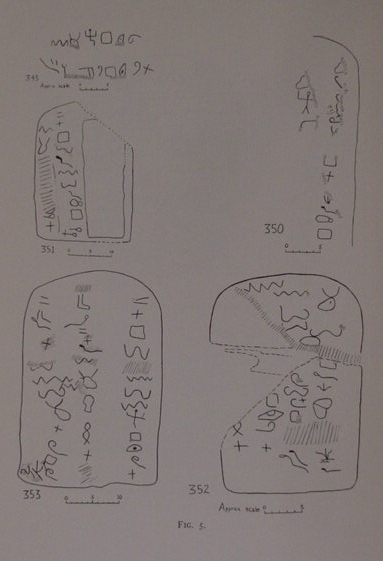Possible precursors of the Ten Commandments (Found at Serabit el Khadim, The Sinai)?
Walter R. Mattfeld
Revision Update of 13 October 2019
Proto-Sinaitic inscribed stelae, Nos. 350, 351, 352, 353
350, p.19, Steliform rock panel near a mine entrance, "O my god (El) rescue [me] from the interior of the mine. swear to bring [a sacrifice].
351, p. 20, Steliform rock panel near mine entrance. "[O Merciful One, with] the Serpent Lady, lords of the mines of Wawat, swear [to bring] a sacrifice"
352, p.20-21, Steliform rock panel near mine entrance. "Itha son of Zur, give me an oracle. Thou who didst save [me] from two lio[nesses, gr]ant me a resting place (?). swear to bring a sacrifice [...a wild] cow."
353, p.21-22. Steliform rock panel, near mine entrance. "O Serpent Lady, his (!) mistress, bring a sacrifice, [be]fore the Lord of Jackals present a wild cow, [before] the Lord of the Winepress present a wild ewe on behalf of Gulyan.
(Source: William Foxwell Albright. The Proto-Sinaitic Inscriptions And Their Decipherment. Cambridge. Harvard Univerity Press. 1966)
As these stele-like inscriptions appear carved into the sides of mountains near mine entrances, could they have inspired for later generations who beheld them, the notion of God (EL, Elohim, Yahweh) calling Moses up to Mt. Sinai, with two hewn tables of stones and the finger of God, inscribing the Decalogue or Ten Commandments on them ?
Beit-Arieh, an Israeli archaeologist who has excavated in the Sinai, has noted that a number of these stone tablets were found STREWN UPON THE GROUND at the beginning of the 20th century. They were made by Asiatic miners, and some were found in association with their graves or burial tumuli (they being invocations asking for a sacrifice to be made to their god by the living). Could these tablets, strewn upon the ground, in association with graves, be what is behind the Exodus narratives of Moses breaking the two stone tablets carrying the Decaloque or Ten Commandments, casting them to the ground ? The graves near the strewn tablets became the graves of the thousands who perished in the worship of the Golden Calf ?
The Exodus is dated circa 1447 BCE acording to 1 Kings 6:1, which states it was 480 years between the Exodus and the 4th year of Solomon (ca. 966 BCE), when he began to build the Temple at Jerusalem. According to Albright, the Proto-Sinaitic inscriptions date from ca. 1550-1450 BCE (p.8). Albright understands that Hyksos slaves from Egypt worked the mines near Serabit el-Khadim and wrote some of these inscriptions (p.12).
Sir Alan Gardiner (1912) dated the inscriptions to the 12 th Dynasty, a view endorsed by Raphael Giveon (pp. 140-143. The Stones of Sinai Speak. Tokyo. Gakuseisha. 1978), a prominent Israeli Egyptologist. Recently, Professor Darnell of Yale found similar inscriptions in the desert west of Memphis, which he dates to the 12th Dynasty.
The below examples of Proto-Sinaitic Inscriptions are from Sass' scholarly work (Benjamin Sass. The Genesis of the Alphabet and Its Development in the 2d Millennium BC. 1988. Wiesbaden. Otto Harrassowitz)
Sass questions the translations made by Albright (see the above example), noting that he was very free in "imagining" words or signs where they were absent or indistinct ("lucunae").
After reviewing various scholarly arguments, Sass noted that the issue as to just when to date these insriptions was still not clear, although he personally preferred the 12th Dynasty.
A word of warning:
The examples on this page suggest tablets with rounded tops (rather like the tables shown in Moses' hands in numerous 19th century AD art works). In fact, they are not tablets at all. They are inscriptions which were "originally" on the sides of mountains or on the walls of mining caves, which separated from the living rock, due to the forces of Nature, that is to say, due to weathering and erosion, and evidently later falling into other debris at the mountain's foot. Some stelae were apparently found near burial tumuli so they might qualify as "tables of stone or tablets."
